How does innovation impact people's lives?
In the latter 1700s, inventions in the textile industry in Great Britain were the first signs of major changes in a revolution in production that greatly altered many aspects of society. Steam-powered machines began to do what animals or people had formerly done by hand. Textile mills could produce high quality cloth cheaply and in huge quantities. Factories sprang up, creating new jobs for factory workers but driving individual weavers who usually worked at home out of business and leading to the growth of cities. Industrialization spread to the iron industry, creating greater demands for mining of ore and coal. Soon the factory system spread to the rest of Europe and the United States. For their owners, factories could create great wealth. Workers, however, often toiled for long hours for low pay under harsh working conditions.
Industrialization of Agriculture
A tremendous growth of machine-power transformed agriculture in the 19th century. Using factory-produced machinery like the steel plow, the reaper, mowers and threshing machines powered by horses, farmers were able to expand the size of their operations and produce far more than they could when farming was done by hand. The invention of the cotton gin to separate seeds from the cotton fiber made cotton-growing profitable and increased the enslavement and abuse of people in southern states. Over the long term, it greatly reduced the number of people required to produce the nation’s food and fiber. Around 1800, nearly 90 percent of Americans were farm families. Today, the number is under two percent. The growth of cities was a direct outcome of the Industrial Revolution as families left the farms to find work elsewhere.
Transportation, Electricity and More
By the mid-1800s, changes in transportation were making a big difference. Steam powered ships could travel much faster than those depending on the winds. Railroads were able to haul freight, mail and passengers long distances with greater convenience and reliability than horse-drawn vehicles. The invention of Morse code enabled rapid communication across great distances and helped draw the nation closer together. Telephones followed giving individuals the power to converse whenever they wanted regardless of whether they were together or not.
In the late 1800s, electricity began its revolution of the home and office. Light bulbs replaced smoky kerosene lamps, refrigerators replaced home deliveries of ice and electric washing machines and irons relieved some of the heavy drudgery of housework. At first, electricity was available only in towns because of the expense of stringing long lines through the countryside, but in 1936, Congress passed the Rural Electrification Act that helped to finance the creation of rural co-operatives to supply farm families with this advantage.
Beginning in the early 20th century, gasoline-powered engines led to the development of automobiles and tractors that further reduced our dependence on horses. Henry Ford built a factory that broke down the manufacture of an automobile into many small steps and allowed him to mass produce the Model-T that had a major impact on American life. Now a reliable automobile was available to the average family, providing a mobility undreamed of only a few generations earlier. Families were no longer bound to travel from town to town by rail but could drive where they wanted on short trips or even long family vacations. Farm children could attend high schools and other activities in town.
The invention of the computer, Internet and the entire digital industry is yet another stage of the Industrial Revolution, and one whose impact people are still experiencing. Who knows what another 20 years will bring?
Impact of the Industrial Revolution
With all the advantages of the Industrial Revolution that provides us with goods, services and opportunities unavailable to past generations, there are downsides, too. There is a much greater inequality in wealth, with some super-rich people while others live below the poverty level. Factories and industrialization make great demands on the environment for raw materials and often pollute the air by burning coal or the rivers with toxic dumps of toxic chemicals. Because Americans no longer produce (or even know how to produce) many of the items upon which they depend on, people are vulnerable to forces over which they have little control.
For the past 300 years, civilization has changed more than it had for thousands of years, and those changes are accelerating. What impact will those changes have on the environment and how will it affect the ability to cohabitate the globe with the natural world and other nations? The answers remain to be seen.
Supporting Questions
How did the Industrial Revolution change the production of goods?
- Occupational Portrait of a Watchmaker, between 1840 and 1860 (Image)
- Occupational Portrait of a Blacksmith, between 1850 and 1860 (Image)
- Occupational Portrait of a Woman Working at a Sewing Machine, ca. 1853 (Image)
- Occupational Portrait of Two African American Chimney Sweeps, between 1860 and 1870 (Image)
- African-American Women Weaving Rug at Hampton Institute in Virginia, 1899 (Image)
- Sadie Pfeifer, Child Worker, at Lancaster Cotton Mills in South Carolina, November 30, 1908 (Image)
- "Assembly Line at the Ford Motor Company's Highland Park Plant," ca. 1913 (Image)
- Washing Machine Assembly Line in Maytag Plant in Newton, Iowa, 1949 (Image)
- "More Than Just Washing Machines" Article about Maytag Plant in Newton, Iowa, June 21, 2019 (Document)
- Barrel Makers in Union, Iowa, Date Unknown (Image)
- "Rise of Industrial America: Work in the Late 19th Century" from Library of Congress (Document)
How did the changes in communication and transportation affect people's lives?
- "First Telegraphic Message" from Samuel Morse, May 24, 1844 (Image)
- Building of the Boone Viaduct (Kate Shelley High Bridge), December 8, 1900 (Image)
- First Flight of Wright Brothers in Kitty Hawk, North Carolina, December 17, 1903 (Image)
- Post Office in Solon, Iowa, ca. 1910 (Image)
- Alfred Solbrig Sitting on His Aviator Father's Curtiss Hydroaeroplane, ca. 1912 (Image)
- Downtown Intersection in Front of William Crewse Drug Company in Des Moines, Iowa, 1930 (Image)
- "Carrying the Load" Essay from The Goldfinch, November 1983 (Document)
- Excerpt from "Getting Away From It All" Essay from The Goldfinch, November 1983 (Document)
- "Railroads in Iowa" Essay from The Goldfinch, November 1983 (Document)
- "What Time Is It?" Essay from The Goldfinch, November 1983 (Document)
- Chicago & North Western Railway Viaduct (Kate Shelley High Bridge) at Boone Data Papers, August 1995 (Document)
- Workers Assemble Recreational Vehicles at Winnebago Industries in Forest City, 2013 (Image)
- Assembly Line Workers Under an RV at Winnebago Industries in Forest City, Iowa, March 2016 (Image)
- "Forest City-based Winnebago Industries turns 60" Newspaper Article, May 6, 2018 (Document)
- Elevation of Truss, from North, with Train, Date Unknown (Image)
What were the advantages and disadvantages of industrialization?
- Breaker Boys at the Woodward Coal Mines in Kingston, Pennsylvania, ca. 1900 (Image)
- Push Cart Vendors on the East Side of New York, New York, 1900 (Video)
- Tenement Yard in New York, New York, between 1900 and 1910 (Image)
- Young Girls at Spoolers at Lincoln Cotton Mill in Evansville, Indiana, October 1908 (Image)
- Newsies in Hartford, Connecticut, March 1909 (Image)
- People Picking Cranberries in Pemberton, New Jersey, September 1910 (Image)
- Mortaria Family Makes Silk Flowers in New York, New York, February 1912 (Image)
- "Hymn for the Working Children," ca. 1913 (Document)
- Tenement Kitchen in Hamilton County, Ohio, December 1935 (Image)
- "Kids at Work" Essay from The Goldfinch, 1996 (Document)
- "Progress and Unemployment" Excerpt from The Goldfinch, 1996 (Document)
- "Working the Environment" Essay from The Goldfinch, 1996 (Document)
- "Iowa Inventors and Inventions from A to Z" Excerpt from The Goldfinch, 1998 (Document)
- "Rise of Industrial America, 1876-1900" from Library of Congress (Document)
| Industrial Revolution Teaching Guide |
| Printable Image and Document Guide |
"Rise of Industrial America, 1876-1900" from Library of Congress

Description
This information from the Library of Congress explains in the decades following the Civil War, the United States emerged as an industrial giant. Old industries expanded and many new ones, including petroleum refining, steel manufacturing and electrical power, emerged.…
"Iowa Inventors and Inventions from A to Z" Excerpt from The Goldfinch, 1998

Description
This excerpt from The Goldfinch highlights six inventions that made an impact on Iowa, and in some cases, the United States.
Chicago & North Western Railway Viaduct (Kate Shelley High Bridge) at Boone Data Papers, August 1995

Description
The papers are from the Historical American Engineering Record in a report about the construction of the Chicago & North Western Railroad viaduct (Kate Shelley High Bridge) near Boone, Iowa. The viaduct, a long bridge-like structure, is one of the last…
"Progress and Unemployment" Excerpt from The Goldfinch, 1996

Description
This excerpt from The Goldfinch explains how inventions and other technological advances often put people out of one line of work and into another.
"Working the Environment" Essay from The Goldfinch, 1996

Description
In this essay from The Goldfinch, the reader considers how some of Iowa's best-known industries are extractive and the advantages and disadvantages to the industries.
"Hymn for the Working Children," ca. 1913

Description
Fanny Crosby wrote poems and hymns. Throughout her life, she was described as having "a horror of wealth," but never set prices to speak, often refused money and what little she did accept, she gave away almost as soon as she got it. Crosby wrote over 8,000 hymns. This…
"Kids at Work" Essay from The Goldfinch, 1996
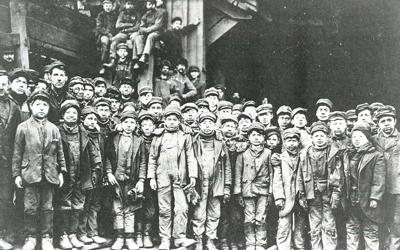
Description
This essay from The Goldfinch explains how most kids in the past, like now, helped out around their homes and learned by working closely with their parents.
"Forest City-based Winnebago Industries turns 60" Newspaper Article, May 6, 2018
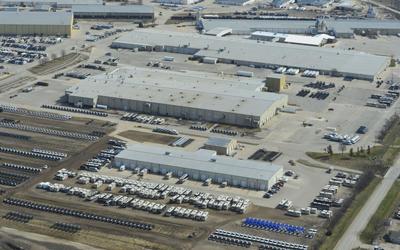
Description
Winnebago Industries started 60 years ago with a dozen workers building travel trailers in a facility shared with a hatchery. Today, the Forest City-based company is a leading U.S. recreation vehicle manufacturer with 4,200 employees. "There's this rich spirit of innovation…
Occupational Portrait of a Watchmaker, between 1840 and 1860
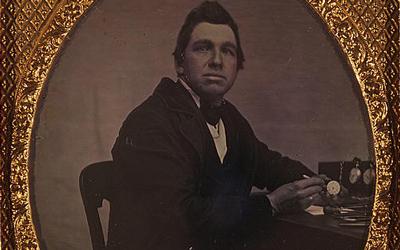
Description
A watchmaker is a craftsman who makes and repairs watches by hand. Peter Henlein, a locksmith and clockmaker from Germany in the 1500s, was the inventor of the world's first watch. In the United States, the railroad chose their own time standards until 1883. Standard time…
Occupational Portrait of a Blacksmith, between 1850 and 1860

Description
A blacksmith is a craftsman who creates things out of iron. They made many things used in everyday life: nails, screws, bolts and other fasteners; horseshoes, sickles, plowshares, axes and other agricultural tools; hammers, candlesticks and other household objects. They also…
Occupational Portrait of a Woman Working at a Sewing Machine, ca. 1853

Description
A seamstress is a person who sews, someone who earns a living by sewing. At first, women's clothes were made at home by the ladies themselves, their servants or a professional seamstress. Fabrics, increasingly mass produced, became more affordable during the…
Occupational Portrait of Two African American Chimney Sweeps, between 1860 and 1870

Description
A chimney sweep is a person who clears ash and soot from chimneys. Chimney sweeping was one of the more difficult, hazardous and low-paying occupations of the time period. In the northern United States, this trade transitioned from primarily white chimney sweeps to…
African-American Women Weaving Rug at Hampton Institute in Virginia, 1899

Description
This photograph shows African American women learning how to weave rugs in a home economics class. Devices like the weaving shuttles and bobbins were used to make cloth and rugs in larger looms, like the one in this photo. The bobbin carried the yarns to make the cloth. The…
Sadie Pfeifer, Child Worker, at Lancaster Cotton Mills in South Carolina, November 30, 1908

Description
Sadie Pfeifer, just four feet tall, worked half a year. She was one of the many small children at work in Lancaster Cotton Mills tending to a row of spinning machines. Spinning machines are set up in long rows that a spinner would walk along and piece together broken ends.…
"Assembly Line at the Ford Motor Company's Highland Park Plant," ca. 1913

Description
Henry Ford and his engineers constantly searched for ways to speed up car production and keep costs low. The integration of a moving assembly line in Highland Park Plant allowed the company to do just that. From 1908-1927, Ford Motor Company produced over 15 million Model T…
Washing Machine Assembly Line in Maytag Plant in Newton, Iowa, 1949

Description
Employees at work on the washing machine assembly line in the Maytag plant in Newton, Iowa. During the 1950s, the laundry and kitchen appliance industry grew rapidly. Maytag was manufacturing washers and dryers for commercial self-service laundries and commercial operators.…
"More Than Just Washing Machines" Article about Maytag Plant in Newton, Iowa, June 21, 2019

Description
This newspaper article from the Newton Daily News looks at the 60-year production history of Maytag. The Jasper County Historical Society helps preserve important objects and historical milestones of the company.
Barrel Makers in Union, Iowa, Date Unknown

Description
Barrel making or being a cooper is a skilled trade. Everything was stored in these wooden containers; flour, grains, salted meats and fish, water, nails, beer, spirits, whale oil and many more.
"Rise of Industrial America: Work in the Late 19th Century" from Library of Congress
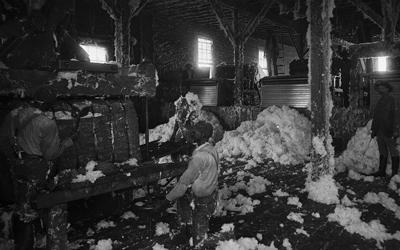
Description
This brief essay from the Library of Congress explains how jobs changed in the time of industrialization.
"First Telegraphic Message" from Samuel Morse, May 24, 1844

Description
When decoded, this paper tape recording of the historic message transmitted by Samuel F. B. Morse reads, "What hath God wrought?" Morse sent it from the U.S. Supreme Court room in the U.S. Capitol in Washington, D.C. to his assistant, Alfred Vail, in Baltimore, Maryland.…
Building of the Boone Viaduct (Kate Shelley High Bridge), December 8, 1900

Description
Also known as the Kate Shelley High Bridge, the Boone Viaduct was completed in 1901 and was one of the highest and longest double-track railroad bridges in the United States. It is located approximately three miles west of Boone, Iowa. According to the Historic…
First Flight of Wright Brothers in Kitty Hawk, North Carolina, December 17, 1903

Description
The photograph shows the first powered, controlled and sustained flight. Orville Wright is at the controls of the machine, lying prone on the lower wing with hips in the cradle which operated the wing-warping mechanism. Wilbur Wright running alongside to balance the machine…
Post Office in Solon, Iowa, ca. 1910

Description
Marie Beuter worked alongside Clara Chansky at the post office from 1968 to 1989. Mail service was received at irregular times due to the road conditions and weather. The first roads followed Native American trails. People rode many miles to get their mail. Postage rates…
Alfred Solbrig Sitting on His Aviator Father's Curtiss Hydroaeroplane, ca. 1912

Description
This photograph shows Albert Solbrig, son of aviator Oscar A. Solbrig, sitting on his father's Curtiss Hydroaeroplane. Oscar built a Curtiss type flying boat powered by a 50 h.p. Roberts motor in which he made one flight. Late in the afternoon and at dusk, he was unable to…
Downtown Intersection in Front of William Crewse Drug Company in Des Moines, Iowa, 1930

Description
This photograph shows the downtown intersection with a streetcar passing in front of William Crewse Drug Company in Des Moines, Iowa, in 1930. Des Moines was the second city in the nation to have electric street railway service. Other Iowa communities were also in the…
"Carrying the Load" Essay from The Goldfinch, November 1983
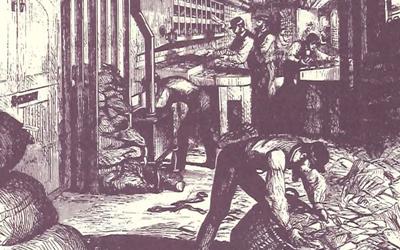
Description
This essay from The Goldfinch explains how the railroad affected people's lives in a variety of ways during the age of industry.
Excerpt from "Getting Away From It All" Essay from The Goldfinch, November 1983

Description
This essay from The Goldfinch describes Carrie Carson's perspective of traveling by railroad in Iowa in 1893.
"Railroads in Iowa" Essay from The Goldfinch, November 1983
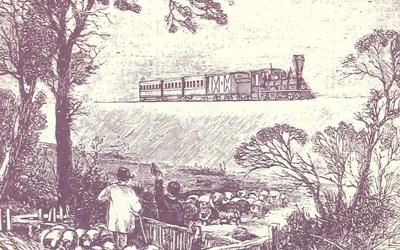
Description
This essay from The Goldfinch explains how the railroad impacted people in Iowa during the age of industry.
"What Time Is It?" Essay from The Goldfinch, November 1983

Description
This essay from The Goldfinch explains how on November 18, 1883, at 12 p.m. (noon), the United States railroads adopted a system for standard time zones.
Workers Assemble Recreational Vehicles at Winnebago Industries in Forest City, 2013
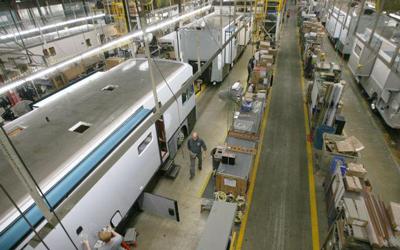
Description
This photograph shows workers assembling recreational vehicles at Winnebago Industries in Forest City, Iowa, from 2013.
Assembly Line Workers Under an RV at Winnebago Industries in Forest City, Iowa, March 2016

Description
Assembly line workers Jared Maas, right, and Stan Trca work under the chassis of an RV on the Winnebago Industries assembly line in Forest City in March 2016. There was not enough room at the north plant, so work began on the new site, nicknamed "Big Bertha." The company…
Elevation of Truss, from North, with Train, Date Unknown

Description
The image shows a view of the Chicago & North Western railroad viaduct (Kate Shelley High Bridge) over the Des Moines River from the north. According to the Historic American Engineering Record, this viaduct is about 3,000 feet long, 185 feet above the Des Moines…
Breaker Boys at the Woodward Coal Mines in Kingston, Pennsylvania, ca. 1900

Description
Breaker boys worked in the coal mines. Their main job was to separate chunks of coal by hand. As coal came down the conveyor belt, they would break up the coal into common sized pieces and also separate out any things like rocks, clay and soil. Boys were usually between the…
Push Cart Vendors on the East Side of New York, New York, 1900

Description
This video features market scenes which show push cart vendors displaying a variety of merchandise on a busy, crowded street in what appears to be a tenement district in New York. The camera is mounted on a moving vehicle and passes horse-drawn wagons and automobiles; young…
Tenement Yard in New York, New York, between 1900 and 1910

Description
In the 19th Century, more and more people began crowding into America's cities, including thousands of newly arrived immigrants seeking a better life than the one they had left behind. In New York City, where the population doubled every decade from 1800 to 1880, buildings…
Young Girls at Spoolers at Lincoln Cotton Mill in Evansville, Indiana, October 1908

Description
Spoolers ran machines that combined the thread from ten to 15 different bobbins. Operating a spooling frame was not a hard job, unless threads broke and they had to tie the strand back together. Working as an investigative photographer for the National Child Labor…
Newsies in Hartford, Connecticut, March 7, 1909

Description
Newsies sold newspapers in the big cities. They were usually homeless orphan boys who had no other way to make money. Newsies were not hired employees. They ran their own business. Each morning they would get up and buy newspapers. Then they would find a good corner with…
People Picking Cranberries in Pemberton, New Jersey, September 1910

Description
This photograph shows some children picking cranberries in Pemberton, New Jersey. The young boy in the middle, Jim Waldine of Philadelphia, Pennsylvania, was just 6 years old and had been picking cranberries two years. Another boy, Sam Frohue, 9, had also been picking…
Mortaria Family Makes Silk Flowers in New York, New York, February 1912

Description
This photograph is of the Mortaria family in their apartment in New York, New York in February 1912. The photo was taken at 8 p.m., but they were all still working at the table because their work - creating silk flowers - was not finished. The small child on the left is not…
Tenement Kitchen in Hamilton County, Ohio, December 1935

Description
Tenements were narrow, low-rise apartment buildings in the city's Lower East Side neighborhood in New York City, which were all too often cramped, poorly lit and lacked indoor plumbing and proper ventilation.
Additional Resources
How did the Industrial Revolution change the production of goods?
- Industrial Revolution
This webpage from the History Channel provides some important historical context about the Industrial Revolution. - Profiling Portraits: Occupational Portraits of the 19th Century
This resource from the Library of Congress provides more information about occupational portraits from the 19th Century and what they tell people about the past. - The Rise of the Industrial Revolution Video
This video focuses on the development of the spinning machine by Sir Richard Arkwright in England, which led directly to the rise of the Industrial Revolution, and a new world of manufactured products. - The Industrial Revolution Video
This video shows an assembly line at work during the Industrial Revolution. Beginning in the 19th Century, advances in manufacturing revolutionize the American way of life. - Inside Ford's Moving Assembly Line Video
In celebration of the 100th anniversary of the moving assembly line, introduced by Ford Motor Company and led by Henry Ford on October 7th, 1913, the automaker went inside its manufacturing facilities to document the fast-paced and efficient assembly lines. - History of Iowa Farmers - Living History Farms
This webpage from Living History Farms looks at the history of farming in Iowa and the people who are important to its growth. - "Inside the LEGO Factory: How robots & machines make LEGO" Video
This video focuses on the creation of a LEGO by robots and machines. - Invention of the Telegraph
This collection from the Library of Congress includes primary sources from Samuel Morse that follow his journey to creating the telegraph. - Industrial Revolution and Technology from National Geographic
This article from National Geographic highlights inventions created during the Industrial Revolution. - Full of Beams: Henry Ford Grows A Car by Peggy Thomas
This biographical story walks through Henry Ford's life and the challenges that came from it, from the failed tractor that Henry Ford made as a teenager, to the Great Depression, as well as the switch in production that came with the beginning of World War II.
How did the changes in communication and transportation affect people's lives?
- Morse Code & the Telegraph
This webpage focuses on the creation of Morse Code and the telegraph during the Industrial Revolution. - Railroad Hotel Owney Tag - National Postal Museum
This webpage includes a photograph of Railroad Hotel Owney Tag that is on display at the National Postal Museum. Owney was a dog that eventually became the mascot for the U.S. Rail Mail Service. - Public Transit: Iowa Transit History
This webpage from the Iowa Department of Transportation looks at the history of public transit in Iowa. - A Lucky Dog: Owney, U.S. Rail Mail Mascot by Dirk Wales
This book chronicles the travels of Owney, who arrived as a stray puppy at the Albany Post Office, and eventually became the official mascot of the U.S. Rail Mail Service and a solo national and world traveler. - 100 Inventions That Made History: Brilliant Breakthroughs That Shaped Our World (100 in History) by DK
This book presents an in-depth exploration of each invention in unprecedented detail with eye-catching visuals and informative text. - The Revolution in Industry by John Perritano
The book takes a look at how machines changed history. - The Industrial Revolution for Kids: The People and Technology That Changed the World by Cheryl Mullenbach
Learn about the new technologies and new forms of communication and transportation that impacted American life — through the people who invented them and the people who built, operated and used them.
What were the advantages and disadvantages of industrialization?
- The Goldfinch: Automobile Age (November 1982)
Explore this edition of The Goldfinch magazine to learn more about the industrialization of Iowa. - "How Edison, Tesla and Westinghouse Battled to Electrify America"
This article looks at the rivalry in the United States as to the development and implementation of electricity. - Child Labor Across Primary Source Sets and the Library’s Collections
This primary source collection from the Library of Congress looks at the history of child labor in the United States. - National Child Labor Committee Collection
This Library of Congress collection features primary sources from the National Child Labor Committee. - Bandit's Roost, 59½ Mulberry Street
This is a photo collection of Jacob Riis' work capturing New York tenement life in the late 1800s. - Photographs of the Empire State Building Under Construction
This collection from the New York Public Library includes general and detailed views of the Empire State Building under construction showing workers performing various tasks including positioning, welding and riveting steel, hoisting materials and supplies and operating and repairing machinery. - Child Labor Laws
This webpage and video provides historical context about the use of child labor and the development of child labor laws. - Northwest Iowa's Top Industries
This webpage includes pertinent information about Iowa's top industries in the northwest. - Innovation, The Calling Card to the Future
This webpage from Iowa Economic Development looks the industrial future of the state. - Lewis Hine: Exposing Child Labor
This is a photo collection of the work of Lewis Hine to document child labor in the Unites States for the National Child Labor Committee. - Kid Citizen: Congress and Child Labor
This webpage offers educator resources about the history of child labor and child labor laws in the United States. - Kid Citizen: Snap a Photo: Agent of Change
This webpage looks at the work of photographer Lewis Hine and his work documenting child labor in the United States and its impact. - The War Between Bosses and Workers by Diana Star Helmer
This book focuses on the changes in America's big cities due to the Industrial Revolution that created labor problems. By the end of the 1800s, these problems between bosses and workers were forcing much-needed reforms. - The Child Labor Reform Movement: An Interactive History Adventure by Steven Otfinoski
This book is a kind of "choose your own adventure" scenario and it deals with the issues faced by children in the workforce. - Mother Jones and Her Army of Mill by Jonah Winter
A picture book about Mary "Mother" Jones and the 100 children who marched from Philadelphia to New York in a fiery protest against child labor.
Iowa Core Social Studies Standards (4th Grade)
Listed below are the Iowa Core Social Studies content anchor standards that are best reflected in this source set. The content standards applied to this set are middle school-age level and encompass the key disciplines that make up social studies for fourth-grade students.
| No. | Standard Description |
| SS.4.8. | Evaluate how civic virtues and democratic principles have guided or do guide governments, societies, and/or communities. (21st century skills) |
| SS.4.19. | Explain influences on the development and decline of different modes of transportation in U.S. regions. |
| SS.4.20. | Compare and contrast events that happened at the same time. |
| SS.4.23. | Explain probable causes and effects of events and developments. |
| SS.4.24. | Develop a claim about the past and cite evidence to support it. |
| SS.4.25. | Analyze the impact of technological changes in Iowa, across time and place. |